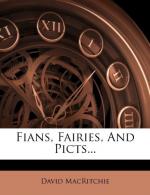The connection visible between Fians and Fairies, between Fians and Picts, and between Picts and Fairies, may now briefly be stated.
The earliest known association of the first two classes occurs in an Irish manuscript of the eleventh or twelfth century,[21] wherein it is stated that when the ninth-century Danes overran and plundered Ireland, there was nothing “in concealment under ground in Erinn, or in the various secret places belonging to Fians or to Fairies” that they did not discover and appropriate. This statement receives strong confirmation from a Scandinavian record, the Landnama-bok, which says[22] that, in or about the year 870, a well-known Norse chief named Leif
“went on warfare in the west. He made war in Ireland, and there found a large underground house; he went down into it, and it was dark until light shone from a sword in the hand of a man. Leif killed the man, and took the sword and much property.... He made war widely in Ireland, and got much property. He took ten thralls.”
Although the Scandinavian record does not speak of the owner of the earth-house as either a “Fian” or a “Fairy,” it is quite evident that this is an example of the plundering referred to in the Irish chronicle, and that the Gaels of Ireland seven or eight centuries ago, if not a thousand years ago, regarded the underground people as indifferently Fians and Fairies.[23]
Many other associations of Fians with Fairies are to be seen. In one of the old traditional ballads regarding the Fians, they are described as feasting with Fairies in one of their “hollow” mounds.[24] A Sutherlandshire story relates the adventures of the son of a Fairy woman, who took service with Ossian, the king of the Fians.[25] One of the Fians (Caoilte) had a Fairy sweet-heart.[26] Another of them (Oscar) has an interview with a washerwoman who is a Fairy.[27] A Fenian story recounts how one day the Fians were working in the harvest-field, in the Argyleshire island of Tiree, and on that occasion they had “left their weapons of war in the armoury of the Fairy Hill of Caolas";[28] from which one is to infer that the Fians made use of Fairy dwellings. In the same collection of tales we are told[29] that one time when the Fians were hunting in the Isle of Skye, they left their wives in a dwelling which bore a title “applied to dwellings of the Elfin race.” It is further stated that one popular belief in the Scottish Highlands is that the Fians are still lying in the hill of Tomnahurich, near Inverness, and that “others say they are lying in Glenorchy, Argyleshire."[30] Now, both the Inverness-shire mound and the mounds in Glenorchy are also popularly regarded as the abodes of Fairies.[31] The vitrified fort on Knock-Farril, in Ross-shire, is said to have been one of Fin McCoul’s castles;[32] and Knock-Farril, or rather “a knoll opposite Knock-Farril” is remembered as the abode of the Fairies of that district.[33] Glenshee,




